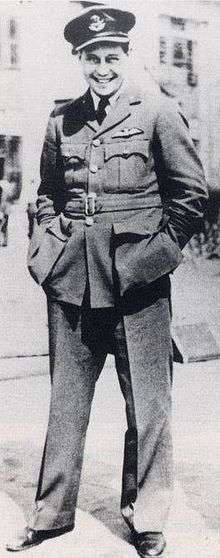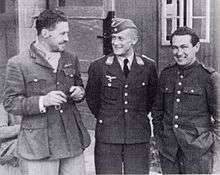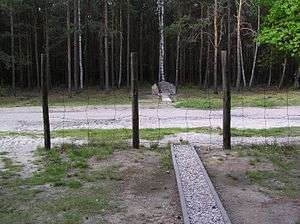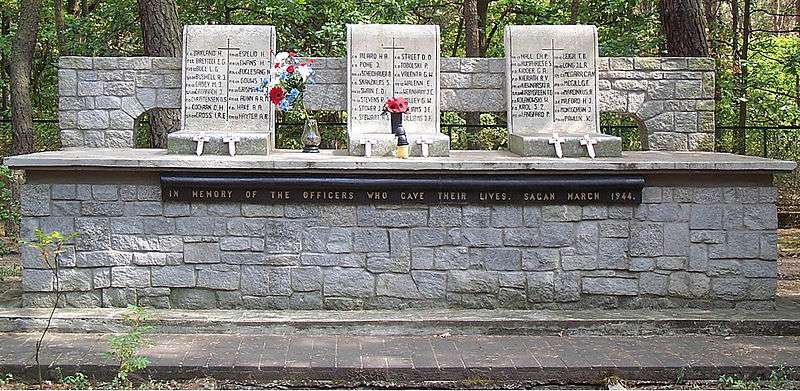Roger Bushell
| Roger Bushell | |
|---|---|
 Bushell in his RAF uniform shortly before his capture | |
| Born |
30 August 1910 Springs, Transvaal, South Africa |
| Died |
29 March 1944 (aged 33) Ramstein, Germany[1] |
| Allegiance |
|
| Service/branch | Royal Air Force |
| Years of service | 1932–1944 |
| Rank | Squadron Leader |
| Commands held | No. 92 Squadron RAF (1939-1940) |
| Battles/wars | World War II |
Squadron Leader Roger Joyce Bushell RAF (30 August 1910 – 29 March 1944) was an Auxiliary Air Force pilot who organised and led an escape from Stalag Luft III, a German prisoner of war camp. He was a victim of the Stalag Luft III murders. The escape was used as the basis for the film The Great Escape. The character played by Richard Attenborough, Roger Bartlett, is modelled on Roger Bushell.
Birth and early life
Bushell was born in Springs, Transvaal, South Africa, on 30 August 1910 to English parents, Benjamin Daniel and Dorothy Wingate Bushell[2] (née White). His father, a mining engineer, had emigrated to the country from Britain and he used his wealth to ensure that Roger received a first class education. He was first schooled in Johannesburg, then aged 14 went to Wellington College in Berkshire, England. In 1929, Bushell then went to Pembroke College, Cambridge, to study law.[3]
Keen on pursuing non-academic interests from an early age, Bushell excelled in athletics[4] and skied for Cambridge in races between 1930 and 1932,[5][6] captaining the team in 1931.[7]
Skiing
One of Bushell's passions and talents was skiing: in the early 1930s he was declared the fastest Briton in the male downhill category. He even had a black run named after him in St. Moritz, Switzerland, in recognition of the fact that he had set the fastest time for the run.[3] He also won the slalom event of the annual Oxford-Cambridge ski race in 1931.[7]
At an event in Canada, Bushell had an accident in which one of his skis narrowly missed his left eye, leaving him with a gash in the corner of it. Although he recovered from this accident, he still had a dark drooping in his left eye as a result of scarring from his stitches.[4]
Bushell became fluent in French and German, with a good accent, which became extremely useful during his time as a prisoner of war.[8]
Career

RAF Auxiliary and legal career
Despite his sporting prospects, one of Bushell's primary wishes was to fly. In 1932 he joined 601 Squadron Auxiliary Air Force,[9] which was often referred to as "The Millionaires' Mob" because of the number of wealthy young men who paid their way solely to learn how to fly during training days (often at weekends).[3] He was commissioned on 10 August 1932 and promoted to flying officer on 10 February 1934[10] and flight lieutenant on 20 July 1936.[11]
Although Bushell was pursuing a career with the RAF, he was not hampered in his attempts to become a barrister-at-Law of Lincolns Inn, London.[2] From the outset of his legal career many commented on his ability as a lawyer, particularly in criminal defence. After a while, Bushell was appointed to military cases in prosecuting RAF personnel charged with various offences. These often involved pilots charged with dangerous flying. In October 1939, acting as assistant to Sir Patrick Hastings, he successfully defended two RAF pilots, John Freeborn and Paddy Byrne, court martialled after the friendly fire incident known as the Battle of Barking Creek.[12] Byrne would later be incarcerated with Bushell at Stalag Luft III.[13]

Regular military career
Bushell was given command of 92 Squadron in October 1939. His promotion to squadron leader was confirmed on 1 January 1940.[14] During the squadron's first engagement with enemy aircraft on 23 May 1940, whilst on a patrol near Calais, he was credited with damaging two Messerschmitt Bf 110 fighter aircraft of ZG 26 before being shot down himself, probably by future ace Oberleutnant Günther Specht.[15] He crash-landed his Spitfire on German-occupied ground and was captured before he had a chance to hide.[4]
He became a prisoner of war and was sent to the Dulag luft transit camp near Frankfurt with all other captured aircrew.
Prisoner of war
On arrival at Dulag Luft he was made part of the permanent British staff under the senior British officer Wing Commander Harry Day. The permanent staff's duty was to help newly captured Allied aircrew to adjust to life as a prisoner of war.
Escape, which was regarded as a duty of all prisoners of war of officer rank, was never far from his mind and, fortunately, he was in good company with Day and Fleet Air Arm pilot Jimmy Buckley. Day placed Buckley in charge of escape operations, with Bushell as his deputy. The three of them formed the escape committee responsible for all escape attempts.
First escape
The permanent staff of the camp started several escape tunnels, one of which was completed in May 1941. Bushell was given a place in the tunnel, but elected to escape on the same day as the tunnel break by cutting through the wire surrounding a small park in the camp grounds. His decision for not using the tunnel was to allow him an earlier get away, thus enabling him to catch a particular train.
The exact date of the escape is not known, but is believed to have occurred in June 1941. Bushell hid in a goat shed in the camp grounds and, soon as it was dark enough, he crawled to the wire and made good his escape.
He was recaptured on the Swiss border, only a few hundred yards from freedom, by a German border guard. He was treated well and returned to Dulag Luft before being transferred to Stalag Luft I with all the 17 others who had escaped in the tunnel (including Day and Buckley).
He was at Stalag Luft I for only a short period before being transferred to Oflag X-C at Lübeck. At this camp he participated in the construction of another tunnel, but this was abandoned unfinished when the camp was evacuated.
Second escape
All British and Commonwealth Officer POWs were removed from the camp on 8 October 1941 and were entrained for transfer to Oflag VI-B at Warburg.
During the night of 8/9 October 1941, the train stopped briefly in Hannover, where Bushell and a Czech officer Pilot Officer Jaroslav Zafouk jumped from the train and escaped, unnoticed at the time by the German guards. Earlier in the journey six other officers had escaped by jumping off the train while it was moving slowly; one was immediately recaptured and one officer was killed when he fell under the wheels.
Bushell and Zafouk made their way to Prague in occupied Czechoslovakia. Using Zafouk's contacts, they made contact with the Czech underground movement. They stayed in 'safe houses' while arrangements for their onward journey was being made. However, luck was not with them, and following the assassination of Reinhard Heydrich in May 1942, the Germans launched a massive manhunt for the assassins; during the round-up, Bushell and Zafouk were arrested. Both were interrogated by the Gestapo and were very roughly treated. Bushell was eventually sent to Stalag Luft III at Sagan, arriving there in October 1942. Zafouk was sent to Oflag IV-C at Colditz.
He took over control of the escape organisation from Jimmy Buckley, who was being transferred to another camp. He became known as "Big X" of the camp escape committee and was the mastermind behind the mass escapes that occurred from the camp. During his stay with the Gestapo he had witnessed the terror and suffering of many at the hands of the Nazis and developed an intense hatred for them. His plan was to strike back at the Germans as best he could — by organising mass break-outs from the POW camps he was in. One of them became known as the "Great Escape", which planned to allow 200 men to escape on a single night.[4]
The Great Escape
In the spring of 1943, Bushell masterminded a plot for a major escape from the camp. Being held in the north compound where British airmen were housed, Bushell as commander of the escape committee channelled the escape effort into probing for weaknesses and looking for opportunities. Falling back on his legal background to represent his scheme, Bushell called a meeting of the escape committee in the camp and not only shocked those present with its scope, but injected into every man a passionate determination to put every energy into the escape. He declared,
"Everyone here in this room is living on borrowed time. By rights we should all be dead! The only reason that God allowed us this extra ration of life is so we can make life hell for the Hun... In North Compound we are concentrating our efforts on completing and escaping through one master tunnel. No private-enterprise tunnels allowed. Three bloody deep, bloody long tunnels will be dug - Tom, Dick and Harry. One will succeed!" [3]
The simultaneous digging of these tunnels would become an advantage if any one of them were discovered by the Germans, because the guards would scarcely imagine that another two could be well under way. The most radical aspect of the plan was not merely the scale of the construction, but also the sheer number of men that Bushell intended to pass through these tunnels. Previous attempts had involved the escape of anything up to a dozen or twenty men, but Bushell was proposing to get over 200 out, all of whom would be wearing civilian clothes and possessing a complete range of forged papers and escape equipment. It was an unprecedented undertaking and would require unparalleled organisation. As the mastermind of the Great Escape, Bushell inherited the codename of "Big X".[3] The tunnel "Tom" began in a darkened corner of a hall in one of the buildings. "Harry"'s entrance was hidden under a stove. The entrance to "Dick" had a concealed entrance in a drainage sump.[16] More than 600 prisoners were involved in their construction.[17]

Tom was discovered in August 1943 when nearing completion. Bushell also organised another mass break out, which occurred on 12 June 1943. This became known as the Delousing Break, when 26 officers escaped by leaving the camp under escort with two fake guards (POWs disguised as guards) supposedly to go to the showers for delousing in the neighbouring compound. All but two were later recaptured and returned to the camp, with the remaining two officers being sent to Oflag IV-C at Colditz for attempting to steal an aircraft.
After the discovery of Tom, construction on Harry was halted. but it resumed in January 1944. On the evening of 24 March, after months of preparation, 200 officers prepared to escape. But things did not go as planned, with only 76 officers managing to get clear of the camp.[4]
Roger and his partner Bernard Scheidhauer, among the first few to leave the tunnel, successfully boarded a train at Sagan railway station. They were caught the next day at Saarbrücken railway station, waiting for a train to Alsace, which had been annexed from France by Germany.
Bushell and Scheidhauer were murdered three days later by members of the Gestapo, including Emil Schulz, helped by others. This was a breach of the Geneva Convention and thus constituted a war crime.[4] The perpetrators were later tried and executed by the Allies. Fifty of the 76 escapees were killed in the Stalag Luft III murders.

Roger Bushell is buried at the Poznan Old Garrison Cemetery (Coll. grave 9. A.) in Poznań, Poland.[2]
Bushell was posthumously mentioned in despatches on 8 June 1944 for his services as a POW.[18] This award was recorded in the London Gazette dated 13 June 1946.[19] His name also appears on the war memorial in Hermanus, South Africa, where his parents spent their last years and where they were buried.
See also
Further reading
- Brickhill, Paul (2000). The Great Escape. London, UK: Cassell & Co. ISBN 0-304-35687-5.
- Dix-Peek, Ross (1 February 2010). "The Great Escape and its South African Mastermind". The South African. Archived from the original on 31 August 2014.
- Durand, Arthur (1989). Stalag Luft III: The Secret Story. London, UK: Patrick Stephens. ISBN 978-0-80711-352-3.
- Meserole, Mike (2008). The Great Escape: The Tunnel to Freedom. New York: Sterling Publications. ISBN 978-1-40275-705-1.
- Pearson, Simon (15 August 2013). The Great Escaper: The Life and Death of Roger Bushell – Love, Betrayal, Big X and the Great Escape. Hodder & Stoughton. ISBN 978-1-44476-063-7.
- Rollings, Charles (2004). Wire and Worse. Hersham, UK: Ian Allan. ISBN 978-0-71103-050-3.
- Smith, Sydney (1968). Wings Day. London, UK: Collins.
- Vance, Jonathan F. (2000). A Gallant Company. Pacifica, California: Pacifica Military History. ISBN 978-0-93555-347-5.
- van der Stok, Bram (1987). War Pilot of Orange. Missoula, Montana: Pictorial Histories Publishing Co. ISBN 978-0-93312-689-3.
- Walters, Guy (2013). The Real Great Escape. London, UK: Bantam. ISBN 978-0-593-07190-8.
References
- ↑ "The Fifty". The Porter Family. Retrieved 10 January 2011.
- 1 2 3 "Casualty Details: Bushell, Roger Joyce". Commonwealth War Graves Commission. Retrieved 10 January 2011.
- 1 2 3 4 5 "Squadron Leader Roger Joyce Bushell". Pegasus Archive.
- 1 2 3 4 5 6 Craig, Phil (24 October 2009). "He shot the hero of the Great Escape in cold blood. But was this one Nazi who DIDN'T deserve to hang?". Daily Mail. Retrieved 10 January 2011.
- ↑ "Skiing – Universities' Meeting". The Times. 23 December 1930.
- ↑ "University Ski Race". The Times. 22 December 1932.
- 1 2 "Skiing – Oxford v. Cambridge". The Times. 30 December 1931.
- ↑ "Roger Joyce Bushell (1910–1944)". Find A Grave Memorial. Retrieved 10 January 2011.
- ↑ The London Gazette: no. 33862. p. 5766. 9 September 1932.
- ↑ The London Gazette: no. 34028. p. 1349. 27 February 1934.
- ↑ The London Gazette: no. 34323. p. 5942. 15 September 1936.
- ↑ Yeoman, Christopher; Freeborn, John (2009). Tiger Cub – The Story of John Freeborn DFC. Barnsley: Pen & Sword Aviation. ISBN 978-1-84884-023-2.
- ↑ Haygood, Tamara Miner. "Malingering and Escape: Anglo-American Prisoners of War in World War II Europe" (PDF). War, Literature and The Arts Online. Retrieved 27 August 2010.
- ↑ The London Gazette: no. 34765. p. 25. 2 January 1940.
- ↑ "Oberstleutnant Günther Specht". Aces of the Luftwaffe.
- ↑ "Interactive Map of the Tunnel "Harry" used for the Great Escape". 11 October 2008. Archived from the original on 26 May 2009. Retrieved 24 June 2008.
- ↑ "Two Shropshire lads and the Great Escape". BBC. 24 May 2004. Archived from the original on 6 April 2004. Retrieved 27 May 2009.
- ↑ The London Gazette: (Supplement) no. 36544. p. 2615. 2 June 1944.
- ↑ The London Gazette: (Supplement) no. 37598. p. 2817. 4 June 1946.
External links
- Biography from Pegasus-one.org
- PBS.org Story of the Great Escape
- Roger Bushell website
- POW Camps Museum Zagan website
- Bushell_Scheidhauer.pdf